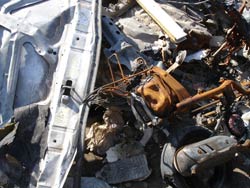Fogarty project provided emergency trauma training to Iraqis
February 2010 | Volume 9, Issue 1
A terrorist explosion ripped through a police office in Erbil, the normally calm capital of Kurdish Iraq, in May of 2005. The suicide bombing killed 60 people and injured several hundred, only the second such attack since the U.S. had invaded Iraq. A well-known terrorist group took responsibility and promised more violence.
After the bomb blast, the Kurdish regional government's health minister, Dr. Jamal Palani, sent out an urgent plea for international help.
"We cannot measure the psychological impact of this on our population," Dr. Palani wrote. "Mass causalities following the suicide bombing were characterized by such a number, severity and diversity of injuries that overwhelmed the ability of local medical resources to deliver comprehensive and definitive care to all victims."

Dhikra Sarsam, Courtesy of Photoshare
Fogarty expanded the scope of a trauma
grant to include Iraq.
The appeal made its way to Fogarty, which quickly expanded the scope of an existing trauma research and training grant to include Iraq.
The grant's principal investigator - Dr. Jon Mark Hirshon of the University of Maryland, Baltimore - swiftly produced a specially tailored training course and assessment tools and traveled to Jordan to lead a five-day intense course. The team included the usual physicians and emergency preparedness trainers as well as law enforcement officers, epidemiologists, and international experts in health and disaster response.
In addition to 17 NIH-supported trainees from Northern Iraq, five individuals from Baghdad also participated, through sponsorship from the World Bank.
Hirshon's team helped the Kurdish health ministry establish a formal medical emergency plan. Components included rescue, decontamination, triage, stabilization, evacuation and treatment plans. They even addressed communications and post-disaster recovery.
"One of the lessons I've learned from this kind of work," says Hirshon, "is that timing is everything. Three weeks after we left the hotel in Jordan, it was bombed."
More Information
To view Adobe PDF files,
download current, free accessible plug-ins from Adobe's website.
Related Fogarty Programs
Related World Regions / Countries